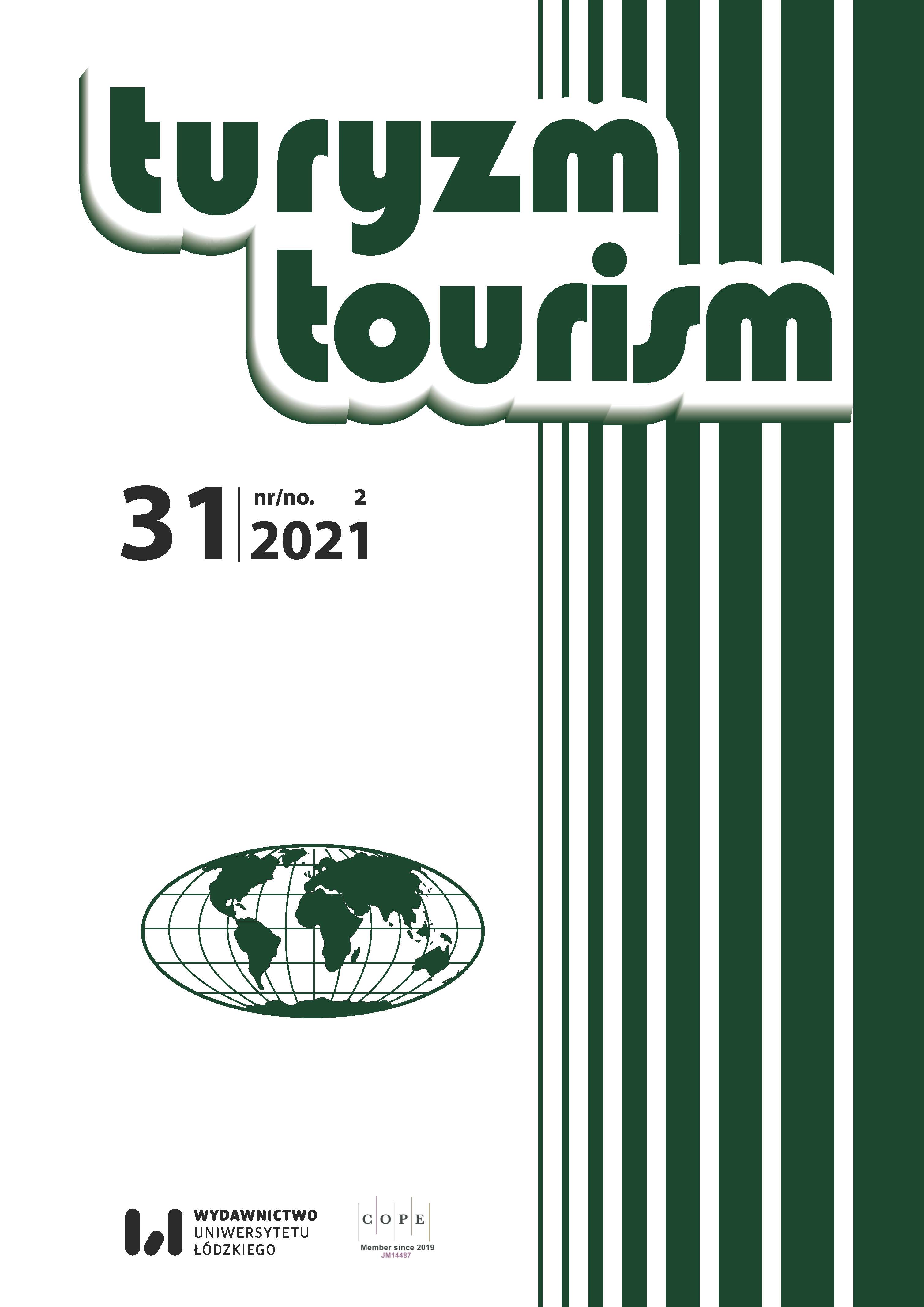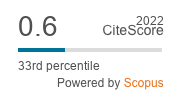Cienka linia między czerwienią a mrokiem: antykomunistyczna turystyka filmowa
DOI:
https://doi.org/10.18778/0867-5856.31.2.01Słowa kluczowe:
muzea antykomunistyczne, mroczna turystyka (dark tourism), turystyka filmowa, czerwona turystyka, IndonezjaAbstrakt
W niniejszej pracy został zgłębiony temat Ruchu 30 Września – ruchu politycznego odpowiedzialnego za nieudaną próbę komunistycznego zamachu stanu w 1965 r. – jako bodźca do zwiedzania muzeów antykomunistycznych. W analizowanym studium przypadku wykorzystano teorię ramową oraz użytkowania i korzyści. Wyniki badania pozwoliły autorom dojść do wniosku, że negatywne fabuły i sceny filmowe mogą zostać wykorzystane jako czynniki motywujące do podejmowania czerwonej lub mrocznej turystyki filmowej. Odwołanie się do takich teorii, jak teoria ramowa czy teoria użytkowania i gratyfikacji wraz z refleksyjną analizą tematyczną, zapewniło możliwość poczynienia unikatowych i wartościowych obserwacji teoretycznych, które mogły zostać pominięte w innych opracowaniach.
Pobrania
Bibliografia
30 September Movement (2020). Retrieved from: https://en.wikipedia.org/wiki/30_September_Movement (12.06.2019).
Google Scholar
Adams, K.M. (1998). Domestic tourism and nation-building in South Sulawesi. Indonesia and Malay World, 26 (75), 77–96. https://doi.org/10.1080/13639819808729913
Google Scholar
DOI: https://doi.org/10.1080/13639819808729913
Adams, K.M. (2016). Tourism and ethnicity in insular Southeast Asia: Eating, praying, loving and beyond. Asian Journal of Tourism Research, 1 (1), 1–28. https://doi.org/10.12982/AJTR.2016.0001
Google Scholar
DOI: https://doi.org/10.12982/AJTR.2016.0001
Azevedo, A. (2017). Lighthouse tourism: Is there a „dark” side? International Journal of Tourism Cities, 4 (1), 54–67. https://doi.org/10.1108/IJTC-03-2017-0019
Google Scholar
DOI: https://doi.org/10.1108/IJTC-03-2017-0019
Beeton, S. (2016). Film-induced tourism. Bristol–Buffalo–Toronto: Channel View Publications. https://doi.org/10.21832/9781845415853
Google Scholar
DOI: https://doi.org/10.21832/9781845415853
Bencivenga, A., Chiarullo, L., Colangelo, D. (2015). Film tourism in Basilicata. Almatourism – Journal of Tourism, Culture and Territorial Development, 6 (4), 241–260.
Google Scholar
Bolan, P., Boy, S., Bell, J. (2011). „We’ve seen it in the movies, let’s see if it’s true”. Authenticity and displacement in film-induced tourism. Worldwide Hospitality and Tourism Themes, 3 (2), 102–116. https://doi.org/10.1108/17554211111122970
Google Scholar
DOI: https://doi.org/10.1108/17554211111122970
Bowyer, E. (2017). The Influence of heritage sites as filming locations on tourists’ decisions to visit sites and their perceptions of them. Case study: „Game of Thrones”. Coactivity: Philosophy, Communication / Santalka: Filosofija, Komunikacija, 25 (1), 110–122. https://doi.org/10.3846/cpc.2017.286
Google Scholar
DOI: https://doi.org/10.3846/cpc.2017.286
Braun, V., Clarke, V. (2019). Reflecting on reflexive thematic analysis. Qualitative Research in Sport Exercise and Health, 11 (4), 589–597. https://doi.org/10.1080/2159676X.2019.1628806
Google Scholar
DOI: https://doi.org/10.1080/2159676X.2019.1628806
Brown, D., Lauricella, S., Douai, A., Zaidi, A. (2012). Consuming television crime drama: A uses and gratifications approach. American Communication Journal, 14 (1), 47–60.
Google Scholar
Cardoso, L., Estevão, C., Fernandes, C., Alves, H. (2017). Film induced tourism: A systematic literature review. Tourism & Management Studies, 13 (3), 23–30. https://doi.org/10.18089/tms.2017.13303
Google Scholar
DOI: https://doi.org/10.18089/tms.2017.13303
Çoban, F. (2018a). Political Reflections on dark tourism: The case of Turkey. In: M. Korstanje, B. George, Virtual traumascapes and exploring the roots of dark tourism (pp. 99–125). Hershey PA: IGI Global. https://doi.org/10.4018/978-1-5225-2750-3.ch006
Google Scholar
DOI: https://doi.org/10.4018/978-1-5225-2750-3.ch006
Çoban, F. (2018b). Dark tourism as a form of governmentality of fear. In: M. Korstanje, B. George, Virtual traumascapes and exploring the roots of dark tourism (pp. 126–149). Hershey PA: IGI Global. https://doi.org/10.4018/978-1-5225-2750-3.ch007
Google Scholar
DOI: https://doi.org/10.4018/978-1-5225-2750-3.ch007
Conway, J.C., Rubin, A.M. (1991). Psychological predictors of television viewing motivation. Communication Research, 18 (4), 443–463. https://doi.org/10.1177/009365091018004001
Google Scholar
DOI: https://doi.org/10.1177/009365091018004001
Costa, J.H. (2012a). Stuart Hall e o modelo „encoding and decoding”: Por uma compreensão plural da recepção. Revista Espaço Acadêmico, 12 (136), 111–121.
Google Scholar
Costa, J.H. (2012b). Os estudos culturais em debate: Um convite às obras de Richard Hoggart, Raymond Williams & E.P. Thompson. Acta Scientiarum. Human and Social Sciences, 34 (2), 159–168. https://doi.org/10.4025/actascihumansoc.v34i2.17706
Google Scholar
DOI: https://doi.org/10.4025/actascihumansoc.v34i2.17706
Costa, J.H. (2013). A atualidade da discussão sobre a indústria cultural em Theodor W. Adorno. Trans/Form/Ação, 36 (2), 135–154. https://doi.org/10.1590/S0101-31732013000200009
Google Scholar
DOI: https://doi.org/10.1590/S0101-31732013000200009
Costa, J.H., Korstanje, M.E. (2016). Nuevos conceptos, nuevas realidades: Revisando el rol de la belleza en la formación del turismo oscuro. Revista Turismo em Análise, 27 (3), 696–713. https://doi.org/10.11606/issn.1984-4867.v27i3p696-713
Google Scholar
DOI: https://doi.org/10.11606/issn.1984-4867.v27i3p696-713
Croy, W.G. (2004). The Lord of the Ring, New Zealand and tourism: Image building with film. Monash University, Faculty of Business & Economics.
Google Scholar
Curtin, S. (2010). The self‐presentation and self‐development of serious wildlife tourists. International Journal of Tourism Research, 12 (1), 17–33. https://doi.org/10.1002/jtr.734
Google Scholar
DOI: https://doi.org/10.1002/jtr.734
Dolezal, C., Trupp, A. (2015). Tourism and development in Southeast Asia. ASEAS – Austrian Journal of South-East Asian Studies, 8 (2), 117–124.
Google Scholar
Doyle, A. (2006). How not to think about crime in the media. Canadian Journal of Criminology and Criminal Justice, 48 (6), 867–885. https://doi.org/10.3138/cjccj.48.6.867
Google Scholar
DOI: https://doi.org/10.3138/cjccj.48.6.867
Festiani, S., Azizah, N., Rostiyani, Y. (2012). Lubang Buaya, the forgotten museum. Retrieved from: https://republika.co.id/berita/en/travelling-2/12/02/11/lz8646-lubang-buaya-the-forgotten-museum (12.06.2018).
Google Scholar
Fiske, J. (1983). The discourses of TV quiz shows or, school + luck = success + sex. Communication Studies, 34 (3), 139–150. https://doi.org/10.1080/10510978309368135
Google Scholar
DOI: https://doi.org/10.1080/10510978309368135
Foley, M., Lennon, J.J. (1996). JFK and dark tourism: A fascination with assassination. International Journal of Heritage Studies, 2 (4), 198–211. https://doi.org/10.1080/13527259608722175
Google Scholar
DOI: https://doi.org/10.1080/13527259608722175
Freire-Medeiros, B. (2009). The favela and its touristic transits. Geoforum, 40 (4), 580–588. https://doi.org/10.1016/j.geoforum.2008.10.007
Google Scholar
DOI: https://doi.org/10.1016/j.geoforum.2008.10.007
Gan, C., Wang, W. (2015). Uses and gratifications of social media: A comparison of microblog and WeChat. Journal of Systems and Information Technology, 17 (4), 351–363. https://doi.org/10.1108/JSIT-06-2015-0052
Google Scholar
DOI: https://doi.org/10.1108/JSIT-06-2015-0052
Goffman, E. (1974). Frame analysis: An essay on the organization of experience. Cambridge, MA, US: Harvard University Press.
Google Scholar
Handayani, B. (2017). Masih relevankah berkunjung ke Museum Lubang Buaya? Retrieved from: http://www.industry.co.id/read/7124/masih-relevankah-berkunjung-ke-museum-lubang--buaya#.WPY3foMtR18.facebook (30.06.2018).
Google Scholar
Handayani, B., Korstanje, M.E. (2017). Gazing at death: Dark tourism as an emergent horizon of research. New York: Nova Science Publishers.
Google Scholar
Hao, X., Ryan, C. (2013). Interpretation, film language and tourist destinations: A case study of Hibiscus Town, China. Annals of Tourism Research, 42, 334–358. https://doi.org/10.1016/j.annals.2013.02.016
Google Scholar
DOI: https://doi.org/10.1016/j.annals.2013.02.016
Ho, K.K., See-To, E.W. (2018). The impact of the uses and gratifications of tourist attraction fan page. Internet Research, 28 (3), 587–603. https://doi.org/10.1108/IntR-04-2017-0175
Google Scholar
DOI: https://doi.org/10.1108/IntR-04-2017-0175
Ikhwan, H., Yulianto, V.I., Parahita, G.D. (2019). The contestation of social memory in the new media: A case study of the 1965 killings in Indonesia. Austrian Journal of South-East Asian Studies, 12 (1), 3–16.
Google Scholar
Ivanova, M., Buda, D.M. (2020). Thinking rhizomatically about communist heritage tourism. Annals of Tourism Research, 84, 103000. https://doi.org/10.1016/j.annals.2020.103000
Google Scholar
DOI: https://doi.org/10.1016/j.annals.2020.103000
Jordan, P. (2014). Nation branding: A tool for nationalism. Journal of Baltic Studies, 45, 283–303. https://doi.org/10.1080/0162977 8.2013.860609
Google Scholar
DOI: https://doi.org/10.1080/01629778.2013.860609
Kami, M.I. (2017). Tentang Tugu Tani yang Didemo karena Dianggap Simbol Komunis. Detik News. Retrieved from: https://news.detik.com/berita/d-3663965/tentang--tugu-tani-yang-didemo-karena-dianggap-simbol-komunis (25.06.2018).
Google Scholar
Katz, E., Blumer, J.G., Gurevitch, M. (1974). The uses of mass communications: Current perspectives on gratifications research. In: W. Davison, F. Yu (eds), Mass communication research: Major issues and future directions (pp. 19–32). Beverly Hills: Sage Publishing.
Google Scholar
Kim, S., Reijnders, S. (2018). Asia on my mind: Understanding film tourism in Asia. In: S. Kim, S. Reijnders, Film Tourism in Asia (pp. 1–18). Singapur: Springer. https://doi.org/10.1007/978-981-10-5909-4_1
Google Scholar
DOI: https://doi.org/10.1007/978-981-10-5909-4_1
Krcmar, M. (2017). Uses and gratifications: Basic concepts. The International Encyclopedia of Media Effects, 1–13. https://doi.org/10.1002/9781118783764.wbieme0045
Google Scholar
DOI: https://doi.org/10.1002/9781118783764.wbieme0045
Krcmar, M., Greene, K. (1999). Predicting exposure to and use of violent television. Journal of Communication, 49 (3), 25–45. https://doi.org/10.1111/j.1460-2466.1999.tb02803.X
Google Scholar
DOI: https://doi.org/10.1111/j.1460-2466.1999.tb02803.x
kumparanNEWS (2017). Sejarawan LIPI: Tugu Tani Bukan Simbol Komunisme. Retrieved from: https://kumparan.com/@kumparannews/sejarawan-lipi-tugu-tani-bukan-simbol-komunisme (25.06.2018).
Google Scholar
Lennon, J. (2018). Kanchanaburi and the Thai-Burma railway: Disputed narratives in the interpretation of war. International Journal of Tourism Cities, 4 (1), 140–155. https://doi.org/10.1108/IJTC-06-2017-0033
Google Scholar
DOI: https://doi.org/10.1108/IJTC-06-2017-0033
Li, Y., Hu, Z.Y., Zhang, C.Z. (2010). Red tourism: Sustaining communist identity in a rapidly changing China. Journal of Tourism and Cultural Change, 8 (1–2), 101–119. https://doi.org/10.1080/14766825.2010.493939
Google Scholar
DOI: https://doi.org/10.1080/14766825.2010.493939
Loureiro, S.M.C., de Araujo, A.B. (2015). Negative film plot and tourists image and intentions: The case of „City of God”. Journal of Travel & Tourism Marketing, 32 (4), 352–365. https://doi.org/10.1080/10548408.2014.896769
Google Scholar
DOI: https://doi.org/10.1080/10548408.2014.896769
Macionis, N. (2004). Understanding the film-induced tourist. In: International tourism and media conference proceedings. Vol. 4 (pp. 86–97). Melbourn: Tourism Research Unit, Monash University.
Google Scholar
Macionis, N., Sparks, B. (2009). Film-induced tourism: An incidental experience. Tourism Review International, 13 (2), 93–101. https://doi.org/10.3727/154427209789604598
Google Scholar
DOI: https://doi.org/10.3727/154427209789604598
McAllum, K., Fox, S., Simpson, M., Unson, C. (2019). A comparative tale of two methods: How thematic and narrative analyses author the data story differently. Communication Research and Practice, 5 (4), 358–375. https://doi.org/10.1080/22041451.2019.1677068
Google Scholar
DOI: https://doi.org/10.1080/22041451.2019.1677068
Miles, W.F. (2002). Auschwitz: Museum interpretation and darker tourism. Annals of Tourism Research, 29 (4), 1175–1178. https://doi.org/10.1016/S0160-7383(02)00054-3
Google Scholar
DOI: https://doi.org/10.1016/S0160-7383(02)00054-3
O’Connor, N., Flanagan, S., Gilbert, D. (2008). The integration of film‐induced tourism and destination branding in Yorkshire, UK. International Journal of Tourism Research, 10 (5), 423–437. https://doi.org/10.1002/jtr.676
Google Scholar
DOI: https://doi.org/10.1002/jtr.676
Pan, S., Tsai, H., Lee, J. (2011). Framing New Zealand: Understanding tourism TV commercials. Tourism Management, 32 (3), 596–603. https://doi.org/10.1016/j.tourman.2010.05.009
Google Scholar
DOI: https://doi.org/10.1016/j.tourman.2010.05.009
Pan, Z., Kosicki, G.M. (1993). Framing analysis: An approach to news discourse. Political Communication, 10 (1), 55–75. https://doi.org/10.1080/10584609.1993.9962963
Google Scholar
DOI: https://doi.org/10.1080/10584609.1993.9962963
Reijnders, S. (2016). Stories that move: Fiction, imagination, tourism. European Journal of Cultural Studies, 19 (6), 672–689. https://doi.org/10.1177/1367549415597922
Google Scholar
DOI: https://doi.org/10.1177/1367549415597922
Ring, A., Yanamandram, V., Gretzel, U., Dolnicar, S. (2019). Conceptualizing vacation dedication. Current Issues in Tourism, 23 (14), 1732–1736. https://doi.org/10.1080/13683500.2019.1678572
Google Scholar
DOI: https://doi.org/10.1080/13683500.2019.1678572
Rubin, A.M. (1993). Audience, activity, and media use. Communication Monographs, 60 (1), 98–105. https://doi.org/10.1080/03637759309376300
Google Scholar
DOI: https://doi.org/10.1080/03637759309376300
Sabre, C. (2017). Between literary tourism and contents tourism: Marcel Proust and his Madeleine as a tourist attraction. International Journal of Contents Tourism, 2, 1–11.
Google Scholar
Seaton, P.A., Yamamura, T. (2018). Japanese popular culture and contents tourism. London: Routledge. https://doi.org/10.4324/9781315528694
Google Scholar
DOI: https://doi.org/10.4324/9781315528694
Slater, M.D. (2003). Alienation, aggression and sensation seeking as predictors of adolescent use of violent film, computer and website content. Journal of Communication, 53 (1), 105–121. https://doi.org/10.1111/j.1460-2466.2003.tb03008.X
Google Scholar
DOI: https://doi.org/10.1111/j.1460-2466.2003.tb03008.x
Spears, D.L., Josiam, B.M., Kinley, T., Pookulangara, S. (2013). Tourist see tourist do: The influence of Hollywood movies and television on tourism motivation and activity behavior. Hospitality Review, 30 (1), 4.
Google Scholar
Stafford, M.R., Stafford, T.F. (1996). Mechanical commercial avoidance: A uses and gratifications perspective. Journal of Current Issues & Research in Advertising, 18 (2), 27–38. https://doi.org/10.1080/10641734.1996.10505049
Google Scholar
DOI: https://doi.org/10.1080/10641734.1996.10505049
Strange, C., Kempa, M. (2003). Shades of dark tourism: Alcatraz and Robben Island. Annals of Tourism Research, 30 (2), 386–405. https://doi.org/10.1016/S0160-7383(02)00102-0
Google Scholar
DOI: https://doi.org/10.1016/S0160-7383(02)00102-0
Tüzünkan, D. (2017). The relationship between innovation and tourism: The case of smart tourism. International Journal of Applied Engineering Research, 12 (23), 13861–13867.
Google Scholar
Tzanelli, R. (2016). Thanatourism and cinematic representations of risk: Screening the end of tourism. Vol. 176. London: Routledge. https://doi.org/10.4324/9781315624105
Google Scholar
DOI: https://doi.org/10.4324/9781315624105
Viganò, G. (2003). Enogastronomy: A path towards the discovery of the local culture. Mediolan: Univerità Bocconi.
Google Scholar
Walters, T. (2016). Using thematic analysis in tourism research. Tourism Analysis, 21 (1), 107–116. https://doi.org/10.3727/1083 54216X14537459509017
Google Scholar
DOI: https://doi.org/10.3727/108354216X14537459509017
Yin, R.K. (2013). Case study research: Design and methods. Thousand Oaks, CA: Sage Publications.
Google Scholar
Pobrania
Opublikowane
Jak cytować
Numer
Dział
Licencja

Utwór dostępny jest na licencji Creative Commons Uznanie autorstwa – Użycie niekomercyjne – Bez utworów zależnych 4.0 Międzynarodowe.





